How to plant and grow grapes at home
Grapes are often grown in tubs. This method is suitable not only for greenhouses and open ground; the vine is able to grow and bear fruit even in indoor conditions.
Grapes grown in a pot can serve a purely decorative function or become a full-fledged fruit crop. It all depends on the method of planting, care and formation of plants. Is it possible to grow grapes at home and what nuances should you be aware of - further in the article.
Is it possible to grow grapes at home on a windowsill?
Growing grapes at home is a way to decorate your apartment and treat yourself to delicious fruits. The plant has beautiful leaves with five lobes and is easy to shape. With proper and timely pruning, it can be given any shape.
Decorative varieties are distinguished not only by their beautiful shape, but also the unusual brown color of the leaf blades. During the fruiting period, plants decorated with blue or white clusters look especially unusual.
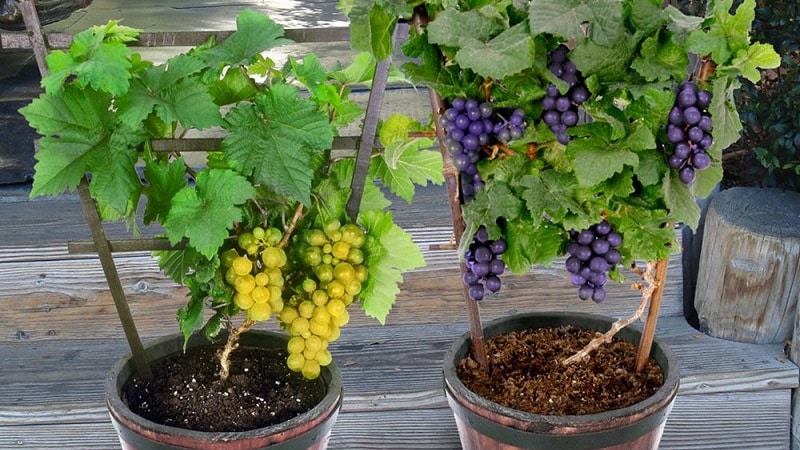
Methods for planting grapes in an apartment
How to grow grapes? There are two ways - generative and vegetative. In the first case, seeds collected from fruits are sown in the ground, in the second, petioles or layering are rooted.
Reference. There is also a grafting method for growing grapes. It is used when a plant with large juicy fruits wants to be grafted onto a frost-resistant root. This method is difficult to implement and is used only in large vineyards; it is not used at home.
Cuttings
At home, the cutting method of growing grapes is most often used.. Properly prepared vine cuttings take root easily and produce the first harvest within 2-3 years after planting the seedling.
Cuttings are bought at the market or obtained independently. To do this, step back 8-15 cm from the end of the vine and make a cut. The resulting pruning should have at least 2-3 live buds. Last year's branches and current year's shoots are suitable.
Before cutting a shoot, it is checked for diseases.. There should be no stains, damage or peeling. The cut site on the mother plant is treated with garden varnish.
Cuttings soak for 1-2 hours in a light pink solution of potassium permanganate. Then they are rolled in sawdust, wrapped in film so that the ends remain outside, and placed in the refrigerator. There they will lie until spring.
Important! During the storage of chibouks in the refrigerator, the sawdust is periodically checked. If they turn black, they are removed. The cuttings are again treated with a solution of potassium permanganate, rolled in new sawdust and wrapped in clean film.
In April or early May, seedlings begin to root. (Chubukov). Before this, part of the bark is removed from the edge of each. If a green layer is found underneath, it means the planting material will take root.
Chubuki are soaked in water for 48 hours. After this they are dried and rooting begins:
- Place a thick layer of gauze on the bottom of the glass. A crushed tablet of activated carbon or a pre-prepared light pink solution of potassium permanganate is poured onto it. Pour enough water into the glass so that it slightly covers the gauze.
- Place the cutting in a glass and cover it with a cut bottle or plastic bag.
- When the roots appear and the cutting grows 1-2 cm, it is planted in the ground.
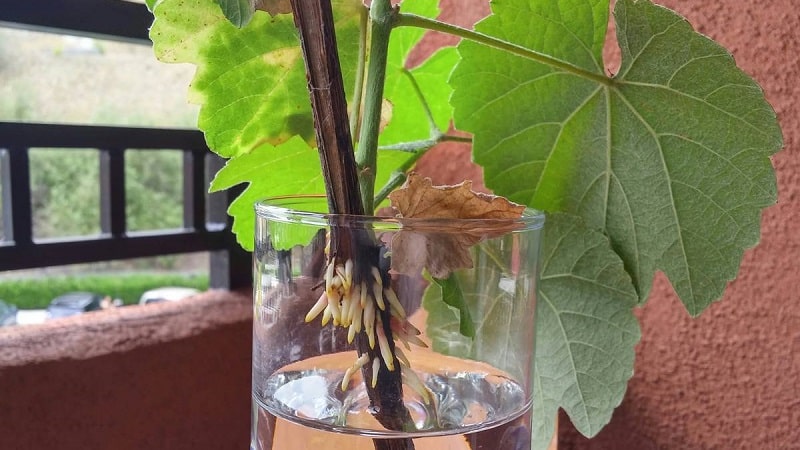
Growing from seed
Growing grapevines from seeds is more difficult. This process takes much longer and allows you to get a harvest no earlier than 5-7 years after planting.
The seeds rarely grow into the same variety from the fruits of which the planting material was collected. Typically, wild grapes are obtained this way.
But plants grown from seeds are distinguished by their unpretentiousness and increased resistance to diseases, cold snaps and lack of light. They are much easier to care for.
Important! Seeds are collected only from ripened fruits.
The collected planting material is prepared:
- Calibration. The seeds are sorted out and all small, thin and damaged specimens are thrown away. Seeds with stains, traces of mold and uneven color are also rejected.
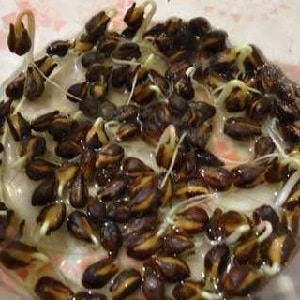 Germination test. Planting material is soaked for half an hour in warm water. Those seeds that sink to the bottom are suitable for planting. Floating specimens are thrown away.
Germination test. Planting material is soaked for half an hour in warm water. Those seeds that sink to the bottom are suitable for planting. Floating specimens are thrown away.- Disinfection. The seeds are soaked for 30 minutes in a light pink solution of potassium permanganate or hydrogen peroxide.
- Stimulation of growth. To make the seeds germinate faster, they are soaked in a growth stimulator for 6-12 hours. They use store-bought (Epin) or folk (aloe juice) remedies.
- Hardening. The bones are put in the refrigerator for 3-4 weeks. Every 7 days they are washed with running water.
- Germination. Cracked specimens are laid out on a piece of damp gauze in a saucer, covered with film and placed in a warm, bright place.
After the seeds germinate, they are planted in the ground. Sprinkle a thin layer of earth on top. The soil is moistened and covered with film.Plants are planted in individual pots after the first leaves appear.
Interesting things on the site:
The best grape varieties to grow at home
Not all varieties are suitable for growing at home. It is recommended to choose low-growing or medium-growing early-ripening grapes - they will bear fruit twice a year.
Varieties that are suitable for growing on a window:
- Mascot;
- Victoria;
- Red Delight;
- Northern;
- Nimrang;
- Laura;
- Indoor nutmeg;
- Malengre early.
How to plant a seedling in a pot
A seedling grown from a cutting or purchased at the market is recommended to be planted in spring. During the active growing season, it will take root and develop faster.
Before planting grapes, select suitable planting material. Seedlings must have a developed root system, hard but elastic bark, and living roots. The height of the trunk is above 2 m.

Preparing the substrate and container
In order for the seedling to take root, prepare the soil. The soil should be loose and fertile. Peat, humus and river sand are mixed in equal proportions. A glass of ash, 35 g of superphosphate, 35 g of urea and 20 g of potassium salt are added to 10 kg of soil mixture. The ingredients are thoroughly mixed.
When growing grapes in an apartment, you will need drainage: small expanded clay or crushed stone, broken ceramics, special filler.
Soil and drainage are disinfected: calcined in the oven, poured with a dark pink solution of potassium permanganate or boiling water.
For the first planting, a container with a volume of 4-5 liters is sufficient.. In the second year, the vine is transplanted into a pot with a volume of at least 8 liters.
Containers are also disinfected – wipe with a dark pink solution of potassium permanganate or a product prepared from a bucket of water and 1 tbsp. l. copper sulfate.
Landing algorithm
Planting grapes at home is a short process:
- The roots of the seedling are cut by a third. Soak in a light pink solution of potassium permanganate for 30 minutes and for 2 days in the root formation stimulator “Kornevin”.
- A layer of drainage 1-2 cm high is poured onto the bottom of the pot. The rest of the space is filled with soil so that 2-3 cm is left free to the edge.
- The seedling is buried in the ground so that it can stand without support. The lower part of the trunk is hilled to form a small mound.
- The plant is watered generously with warm water and covered with film or a cut part of the bottle.
- The seedling is watered as the soil dries. When watering, the vine is sprayed.
- When the buds begin to open on the plant, the film is removed.
Caring for grapes at home
Grapes are an unpretentious plant; they do not need to be given much attention., only carry out basic activities.
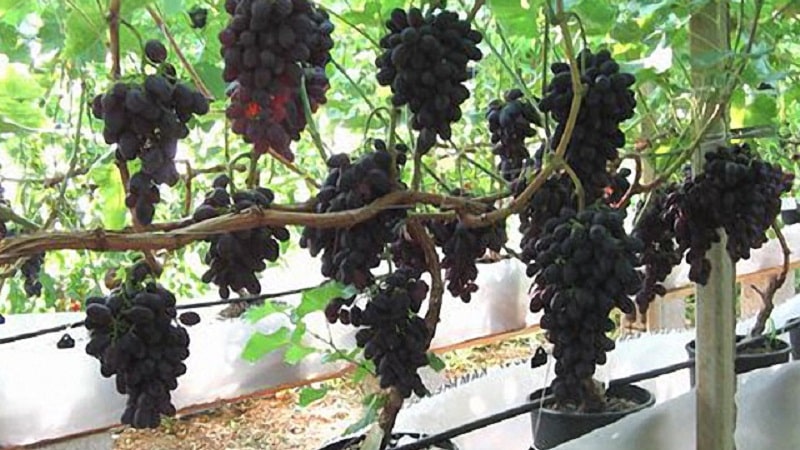
Conditions for growth
The plant is provided with optimal conditions. This will reduce the likelihood of infection and accelerate its growth:
Temperature
During the growing season, room temperature is suitable for grape growth. The optimal range is considered to be +19…+25°C. In winter, the liana feels comfortable at temperatures from 0 to +10°C.
Humidity
When the humidity is less than 70%, the vines begin to dry out. The risk of contracting fungal infections and spider mites increases. To create optimal conditions, the vine is sprayed with warm water once a week. In winter, place a humidifier or containers of water near the pot.
Lighting
Cultivated grapes are demanding of light. It is grown on southern or southwestern windowsills. Wild grapes feel better in shade. It is kept near the north or southeast window.
If the room is cool enough in winter for the plant to go dormant, additional lighting is not required. If the room is warm and a second harvest is planned, in winter use fluorescent lamps located at a distance of 20 cm from the pot.
Note! With a lack of light, the grapes will not die, but they will not set fruit either.
Watering
During the growing season, grapes are watered 1-2 times a week.. The hotter the room, the more often. For irrigation, use warm, settled water. Moistening the soil with cold water is the main reason for the development of root rot.
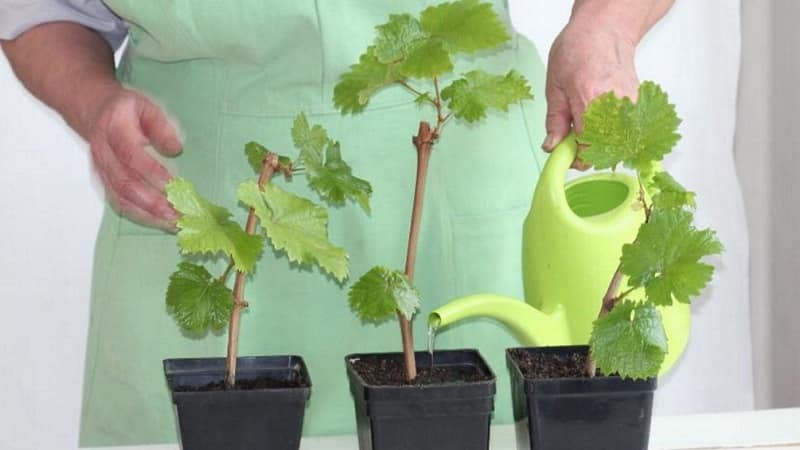
During the fruiting period, the amount of watering is reduced. The soil is moistened no more than once every 10 days. In winter - no more than once every 2 weeks, provided that the room is cool. If the room is warm, water the grapes as usual.
It is recommended to water the plant from a watering can – this way the liquid penetrates into the soil more easily and at the same time loosens the soil.
Read also:
How to grow indoor pomegranate: care features
Feeding and fertilizers
So that the grapes on the windowsill develop quickly, do not get sick and bear fruit, apply fertilizing according to the scheme:
- The first feeding is in early spring. The fertilizer contains potassium, phosphorus and nitrogen. Home remedy option: 1 kg of chicken manure, 9 liters of water, 25 g of superphosphate and 20 g of potassium salts.
- The second and third fertilizing is applied in the summer, before the fruits reach their maximum size. The product must contain potassium salts and phosphorus.
- Fertilizer is applied a fourth time when the berries reach their maximum size. They use a preparation containing phosphorus, potassium and other elements except nitrogen.
- The grapes are fed for the last time during the season in the fall. Use a complex mineral fertilizer that does not include nitrogen and chlorine.
The day before fertilizing the soil is moistened.
Shaping and trimming
 Formation is carried out in autumn or early spring. The strongest new shoots are left on each new branch. They are divided in pairs. One vine of the pair is left untouched, and the second is pruned so that at least 3 buds remain on it.
Formation is carried out in autumn or early spring. The strongest new shoots are left on each new branch. They are divided in pairs. One vine of the pair is left untouched, and the second is pruned so that at least 3 buds remain on it.
After fruiting ends, the long vine is pruned. Shoots sprout from small prunings and are formed according to the method described above.
Sanitary pruning is done every autumn: remove old, dry parts of the plant affected by diseases and pests.
This is interesting! If you shape a grape like a tree, it will make a beautiful bonsai.
Rules for transplantation and transshipment
Before the first fruiting, the grapes are transferred to a freer container annually. To do this, it is removed from the pot along with a lump of earth, a few centimeters of top soil and drainage are removed. A layer of drainage is poured onto the bottom of the new pot and the plant is immersed along with a lump of earth. The missing volume is filled with soil. The grapes are watered.
After the first fruiting, the vine begins to be replanted. This is done once every 2-3 years. When replanting, the plant is removed from the pot and at least one third is cleared of soil. Diseased and damaged roots are removed. Drainage is poured into the pot, grapes are placed there, and the free space is covered with earth. The soil is moistened.
After transplantation, the plant is kept in a shaded place. within 7 days.This will help him adapt.
The vines will need support. To do this, they are let through the window or tied to a rope stretched at an angle.
Conclusion
Grapes can grow not only in open ground or greenhouses. It is even cultivated in pots on windowsills. This is done not only because of its decorative appearance, but also due to its ability to produce crops even in an apartment.
The plant is provided with optimal conditions for development and the basic rules of care are followed: fertilizer is applied once a month and watered once a week.